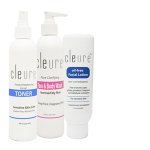Symptoms of a Mold Allergy
Are Your Skin Rashes Really Mold Allergy Symptoms?
What are the symptoms of a mold allergy, and how might this be affecting YOUR sensitive skin?
Many of us that get mysterious skin rashes don't always know the cause of our symptoms. Sometimes even our doctor or dermatologist doesn't know!
One of the things you may not think about when you have sensitive skin is that you might have mold allergy symptoms!
These tips can help you reduce or eliminate your exposure to mold allergens and other irritants in your environment. Try them and see if your skin rashes improve!
How Mold Allergies Affect Your Body
Mold is all around us. Thankfully, most of the time, our body's reaction to mold is so mild that symptoms never appear. However, for some people with mold allergies, the effects can include runny nose, sneezing, upper respiratory problems and gastrointestinal distress.
One of the less common symptoms of a mold allergy involves a rash or hives on the skin. This reaction is often associated with sensitive skin.
How Long Does a Reaction to Mold Take to Manifest?
In some cases, the skin reaction to mold will be immediate. This is called an acute reaction. Milder reactions can take hours or days to develop and may increase in severity if contact with mold persists. The skin may appear red and irritated with a rash or hives developing.
What Does a Skin Reaction to Mold Look Like?
Many cases of skin allergic reactions to mold look similar to eczema. Eczema can appear as red, irritated patches on the skin that swell and itch.
Scratching the areas affected by mold allergies can lead to a skin infection. The skin always has a bit of staphylococcus bacteria on the surface and when infection occurs, impetigo can result. This skin infection is highly contagious and can spread quickly.
How Do I Reduce the Symptoms of a Mold Allergy?
Many times, people who are allergic to mold come in contact with it without their knowledge. Mold on food, for instance, can be microscopic and appear on foods that do not normally require refrigeration. These foods can include nuts and grains. Yeast can also harbor mold with reactions being caused by eating the bread leavened with the yeast.
The first line of defense against a mold allergy is avoidance! These are a few simple steps to reduce your mold exposure can make a big difference in your overall health and the health of your skin.
Natural Tips for Mold Allergy Treatment
- Placing all nuts and grains in the refrigerator can hamper mold growth. Staying away from leavened bread can also reduce contact with invisible mold.
- Use a dehumidifier - If mold is being ingested through the air, it is important to keep the air in your home dry and free from mold. Most natural doctors will begin treatment by taking an account of the home style, furniture styles and flooring styles to assess where the airborne mold could be coming from.
- Clean your closet! - Old shoes, magazine and old clothing can hold on to moisture and mold can develop. Ridding closets of these pieces can reduce contact with airborne mold.
- Replacing bed linens, pillows and comforters on a regular basis is another good practice to reduce symptoms of a mold allergy. These items tend to hold on to moisture and that is what mold requires to grow. You may not see the mold, but it is there and you may be breathing it in every night.
You can also try washing your bed linens in hot water, and adding a little oxygen bleach to the wash to help prevent further mold growth. - Acupuncture is another alternative treatment for mold symptoms. Needles are inserted just into the skin at pressure points to shut down the trigger stimulators. It may take a few months for the treatment to be completely successful, but the track record for success is good.
- Strengthening your immune system is a good idea in all allergy situations, and especially for mold allergy. This can be accomplished by removing as many toxic irritants from your daily life, and by increasing the amount of nutrition your body receives.
My free eBook Clear Any Skin Problem Naturally has a simple, five step program that will show you how to do this gradually in a way that fits YOUR daily life. - Aromatherapy using essential oils can calm the mind and the nasal passages. Mucus can line sinus pathways and cause an immune system reaction. Once the immune system is in full fighting mode, the skin rash and irritation can become worse. Clearing up the mucus with natural aromatherapy scents like peppermint and eucalyptus work wonders.
Home > Common Allergies and Symptoms > Symptoms of a Mold Allergy









New! Comments
Share your thoughts about what you just read! Leave me a comment in the box below.